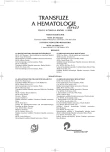Clinical significance of the evaluation of serum levels of immunoglobulin free light chains in monoclonal gammapathies
Klinický význam hodnocení sérových hladin volných lehkých řetězců imunoglobulinu u monoklonálních gamapatií
Cílem sdělení je podání souhrnné informace o současném pohledu na význam hodnocení sérových hladin volných lehkých řetězců imunoglobulinu u jednotlivých typů monoklonálních gamapatií z pohledu potřeb klinické praxe. Úvodem jsou zhodnoceny současné technické možnosti a úskalí vyšetřování monoklonálních imunoglobulinů a jejich strukturálních komponent v séru a/nebo v moči. Hlouběji jsou diskutovány metodické a interpretační aspekty nově zavedené automatizované imunochemické metody umožňující s vysokou senzitivitou a specifitou kvantitativní hodnocení hladin volných lehkých řetězců imunoglobulinů v séru (S-VLŘ). Je zdůrazněn významný přínos vyšetřování hladin S-VLŘ a poměru kappa/lambda především pro diagnostiku Bence-Jonesova, nesekretorického a IgD typu mnohočetného myelomu ale i pro průběžné hodnocení charakteru vývoje nemoci, hloubky léčebné odezvy, dosažení stabilní/“plateau“ fáze, časné detekce progrese či relapsu i léčebné rezistence u všech forem a typů mnohočetného myelomu. Pozornost je věnována rovněž i významu vyšetření hladin S-VLŘ v diagnostice a hodnocení výsledků léčby u primární systémové AL-amyloidózy, primární makroglobulinémie i u méně obvyklých typů MG (solitární plazmocytom, B-typ nehodgkinských lymfomů, nemoc z depozice lehkých řetězců), opomenuta nezůstala ani problematika monoklonální gamapatie nejistého významu. Možno konstatovat, že vyšetřování koncentrace VLŘ v séru, kappa/lambda indexu a jejich změn významným způsobem rozšiřuje dosavadní spektrum standardních ukazatelů, používaných v diagnostice a hodnocení výsledků léčby u jednotlivých typů monoklonálních gamapatií.
Klíčová slova:
volné lehké řetězce imunoglobulinů, automatizovaná imunochemická analýza, Bence-Jonesův myelom, nesekretorický myelom, AL-amyloidóza, primární makroglobulinemie, monoklonální gamapatie nejistého významu, diagnóza, terapie
Authors:
V. Ščudla; M. Vytřasová; J. Minařík
Authors‘ workplace:
III. interní klinika LF UP a FN, Olomouc
Published in:
Transfuze Hematol. dnes,11, 2005, No. 2, p. 47-53.
Category:
Comprehensive Reports, Original Papers, Case Reports
Overview
The study is aimed at current view of significance of evaluation of serum immunoglobulin free light chain levels in different types of monoclonal gammapathies according to clinical practice needs. In the beginning, current technical means and pitfalls of the examination of monoclonal immunoglobulins and their structural components in serum and/or urine were evaluated. Methodical and interpretative aspects of a new established automated immunochemical method are described more deeply. It enables quantitative evaluation of serum free light chains (S-FLC) with high sensitivity and specificity. Significant benefit of the evaluation of both S-FLC levels and kappa/lambda ratio, particularly for the diagnosis of Bence-Jones, non-secretory and IgD multiple myeloma, is emphasized in this paper. It is also important for the continuous evaluation of the progression of the disease, response to treatment, and stable “plateau” achievement, early detection of the progression or relapse of the disease as well as treatment resistance in all types of multiple myeloma. The attention is also paid to the importance of the examination of S-FLC for the diagnosis and evaluation of the treatment of primary systemic AL-amyloidosis, primary macroglobulinaemia as well as less common types of MG (solitary plasmocytoma, B-type non-Hodgkin’s lymphoma, light-chain deposition disease). Issues of monoclonal gammapathy of undetermined significance were also mentioned. It can be claimed that examination of the serum FLC, kappa/lamda ratio and theirs changes significantly extend spectrum of standard parameters using for the diagnosis and evaluation of the outcome of several types of monoclonal gammapaties treatment.
Key words:
immunogloblulin free light chains, automated immunochemical analysis, Bence-Jones myeloma, nonsecretory myeloma, AL-amyloidosis, primary macroglobulinaemia, monoclonal gammapathy of undetermined significance, diagnosis, therapy
Labels
Haematology Internal medicine Clinical oncologyArticle was published in
Transfusion and Haematology Today

2005 Issue 2
- What FVIII Levels Are Ideal for Preventing Bleeding in Hemophilia A?
- Cost Effectiveness of FVIII Substitution Versus Non-Factor Therapy for Hemophilia A
- Vascular Disease in the Gradually Aging Population of Hemophiliacs: An Underestimated Problem?
- Prognostic Significance of Subclinical Joint Changes on MRI in Hemophilia
- Immunotolerance is still the goal of management of hemophilia A with inhibitor in the era of non-factor therapy
Most read in this issue
- Hodgkin’s lymphoma therapy results with a view to the treatment of relapses and primary progression
- Clinical significance of the evaluation of serum levels of immunoglobulin free light chains in monoclonal gammapathies
- LIFE 18 – the first contact with an integrated device for treatment by means of immunoadsportion
- Selection of blood donors for the multicomponent blood collection
